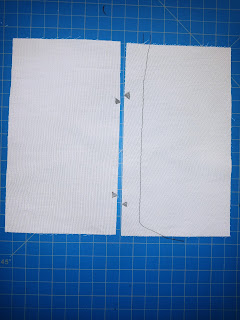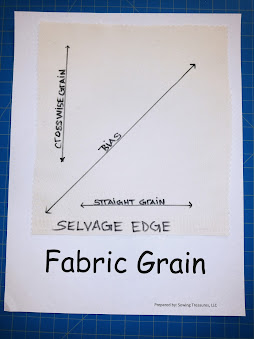Welcome to the final post discussing definitions of sewing terms. If you missed any part of the Sewing Terms and Definition Series, you can catch them here.
Today we will be reviewing pattern notches, pressing, pressing cloth, remnants, seam allowances, seam layering, selvage, tailor’s tacking, and under-stitching.
PATTERN NOTCHES: triangular
markings on the pattern edges that are used to match up fronts to backs,
collars to necklines, and waistbands to waist edge, etc. Cut out around notches
rather than into the seam allowances to prevent unnecessary fraying. Follow the
guidelines and cut double or single notches as shown as these will help with
matching pieces together accurately.
PRESSING: this differs from ironing in that you do not glide the iron back and forth; instead, the iron is lowered onto the fabric, held for 30 seconds, lifted, and lowered again. This technique prevents a shine from coming onto your fabric and it helps to keep the fabric fibers from being distorted. Press seams from the wrong side of the fabric. Only press from the right side when the fabric is protected by a pressing cloth. (No photo included since we all know what an iron looks like! :))
PRESSING CLOTH: a
cloth that is used to protect the main fabric from the iron; an organza piece
of fabric is a very good pressing cloth because it withstands a hot iron and it’s
transparent so you can see what you are pressing. A 100% cotton fabric like
muslin is also a good option to use as a pressing cloth. Either choice is a
great option to help prevent a shine or an accidental burning on your garment
or project.
REMNANTS: are usually discounted
small pieces of fabric, generally about a little over a yard (36 inches or more)
or smaller off cuts of fabric. Remnants are a great way to experiment sewing
with different types of fabrics.
SEAM ALLOWANCES: the fabric between the stitching line and the raw edge of the fabric. This is used to prevent the seams splitting open as the fabric is pulled and stressed to be worn. The seam allowance for home sewing patterns is generally 5/8 of an inch (unless otherwise indicated on the pattern); in the fashion industry the universal standard is 1/2 of an inch (unless otherwise indicated).
SEAM LAYERING: when
sewing three pieces of fabric together within a seam allowance, trim all seams
in layers creating short to long seams (see photo example). This reduces bulk
within the seams and allows the seam to lie flat when pressed; also referred to
as “grading”.
SELVAGE: refers to the edge of fabric as it comes off the bolt. The selvage is the machine finished edges of the fabric which has manufacturer information. This area of the fabric is usually a bound edge that does not fray. The selvage of the fabric may also have color dots which show the colors used in the fabric and lines to indicate the repeat of a print. Special Tip: if you have a fabric that is hard to tell the right side of the fabric, look on the selvage, you will notice small holes, if they are pointed upright, that’s the right side of the fabric since the fabric is printed, woven, or constructed, on the right side.
This concludes our Terms & Definitions Series; I hope you enjoyed. If there are any definitions, you’d like me to review, I would be delighted to review those for you also. If you have any questions or comments, please leave them below. Have a wonderful day!
Until next time!






























































